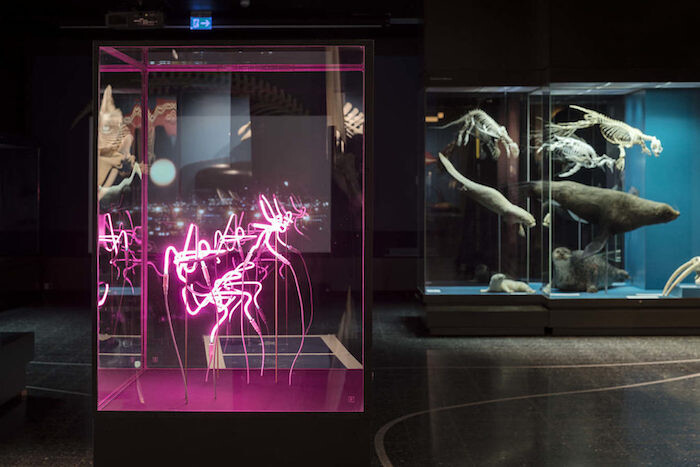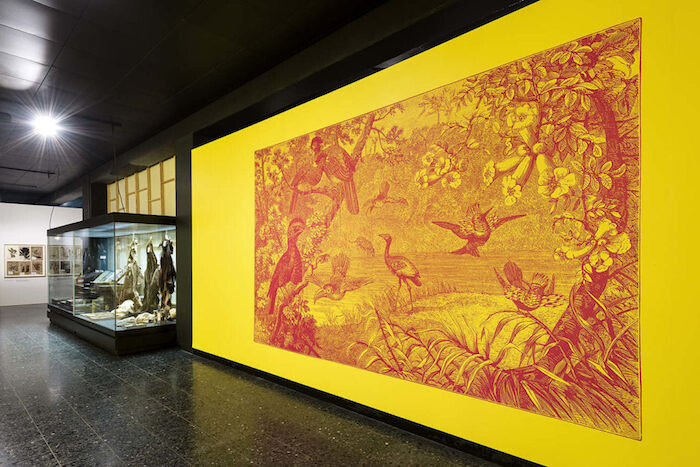Museums are known today as natural habitats for art. But in Renaissance Europe, before their collections specialized in works of art, museums hosted cabinets of curiosities, with their awkward mixtures of rare and bizarre objects. In the eighteenth century, demand arose across Europe to open museum collections—typically owned by royalty, noblemen, and affluent merchants—to the general public. In most cases, artists created products better suited for exhibition than nature did, and over time art and nature museums parted ways. From here, one could almost write a biogeography of the museum as part of an ecosystem that provides space for exhibitable objects.
The term “biogeography” remains tied to the British naturalist Alfred Russel Wallace, a contemporary of Charles Darwin whose contributions to the theory of evolution, though eclipsed by those of his colleague, were pioneering. Yet their approaches differ on one very interesting point. While Darwin argued that competition is evolution’s main driving force, Wallace focused on the diversity caused by geographical separation. That is perhaps one reason why those who wish to encourage eternal struggle and competitiveness—be they capitalists, militarists, or racists—hold Darwin so dear. Today, Wallace is mainly known for the Wallace Line, which marks the boundaries between Asian fauna and that of Australia and the Pacific.
The show “Disappearing Legacies: The World as Forest” hosts 13 artworks, including eight new commissions, embedded among the displays at Hamburg’s Natural History Museum. Seen from Wallace’s perspective, it tests how species of works cultivated in the art world—sculpture, sound art, photography, documentary video—can be reintegrated into the ecospheres of natural history museums. The first time I saw such an attempt to embed art in a museum environment was Zoe Leonard’s striking contribution to Documenta 9 in 1992. Nested between old-master paintings of women at Kassel’s Neue Galerie were a series of monochrome, close-up photographs of vaginas (Vagina, 1992). But there is one significant difference between “Disappearing Legacies” and Leonard’s intervention. Hers was built on alienation and contextual disparity. The works in the Natural History Museum, however, integrate themselves in various ways, either adhering to topics that reflect the contents of museum’s collection or incorporating pieces from it. As the exhibition curators Anna-Sophie Springer and Etienne Turpin have said: “Depictions of tropical biotopes in the habitat dioramas at natural history museums are certainly fascinating. But once you think about it, it becomes obvious how little these displays reflect what happens in the tropical forests of today.”1 Implicit is the claim that natural history museums should escape the past and become contemporary.
What this exhibition reveals about the fate of contemporary tropical rainforests is grim. The invited artists focused their research on parts of the world Wallace travelled to— Amazonia and the Indonesian archipelago—devastated by human activity since. The resulting works could be divided into two broad categories: those that uphold the sovereignty of art, and those that commit to factual documentary. The first category includes three sculptures of pink neon tangled into knot-like forms (Revital Cohen and Tuur van Balen’s Raggiana, Emperor, and Red, all 2017); a gong struck every 19 minutes to mark the estimated rate at which species go extinct (Julian Oliver and Crystelle Vũ’s Extinction Gong, 2017); and photographs of damaged trees (Shannon Lee Castleman’s Tree Wounds, Muna Island, 2017). The second category includes geographer Irendra Radjawali’s aerial photographs of deforested parts of Indonesia made in cooperation with the Indonesian activist group Peta Bencana (Excerpts from Field and Sky, 2016–17), and Maria Thereza Alves’s To See the Forest Standing (2017), a video installation comprising 34 interviews with indigenous people. For sure, the artworks presented within the collection broadened the perspective of the Museum of Natural History. But the integration of artworks and natural history exhibits—an attempt to liberate the museum’s collection from its adherence to historicizing modes of display—was not seamless. For the school classes taking guided tours on the morning I visited, the artistic interventions were, it seemed, incomprehensible.
What made the strongest impression, at least on me, was not the exhibition’s overall curatorial strategy but a single work: Trees, Vines, Palms, and Other Architectural Monuments (2017), a documentary installation produced by the urbanist Paulo Tavares in collaboration with the indigenous Bö’u Xavante Association, about a lost village in a deforested area of Amazonia. After driving through plantation monoculture and devastated steppe, an elderly man of the Xavante people leads us to his place of birth. A rough circle of old trees reveals the exact location. He points to where houses used to stand, and starts to describe what life was like in the village where he grew up.
Interview with Anna-Sophie Springer and Etienne Turpin (translation by Stefan Heidenreich), Centrum für Naturkunde online, 2018, https://www.cenak.uni-hamburg.de/ausstellungen/museum-zoologie/verschwindende-vermaechtnisse/kuratoren-kuenstler/interview.html.










